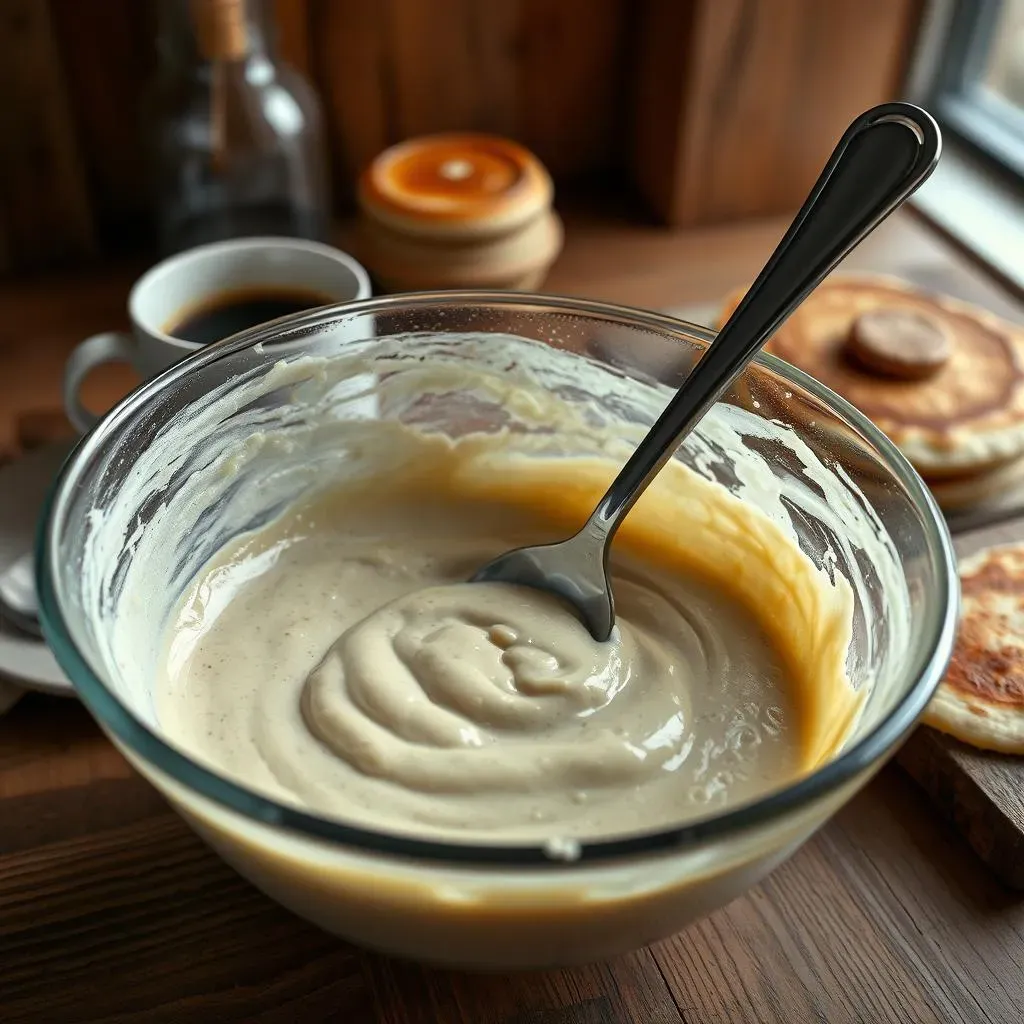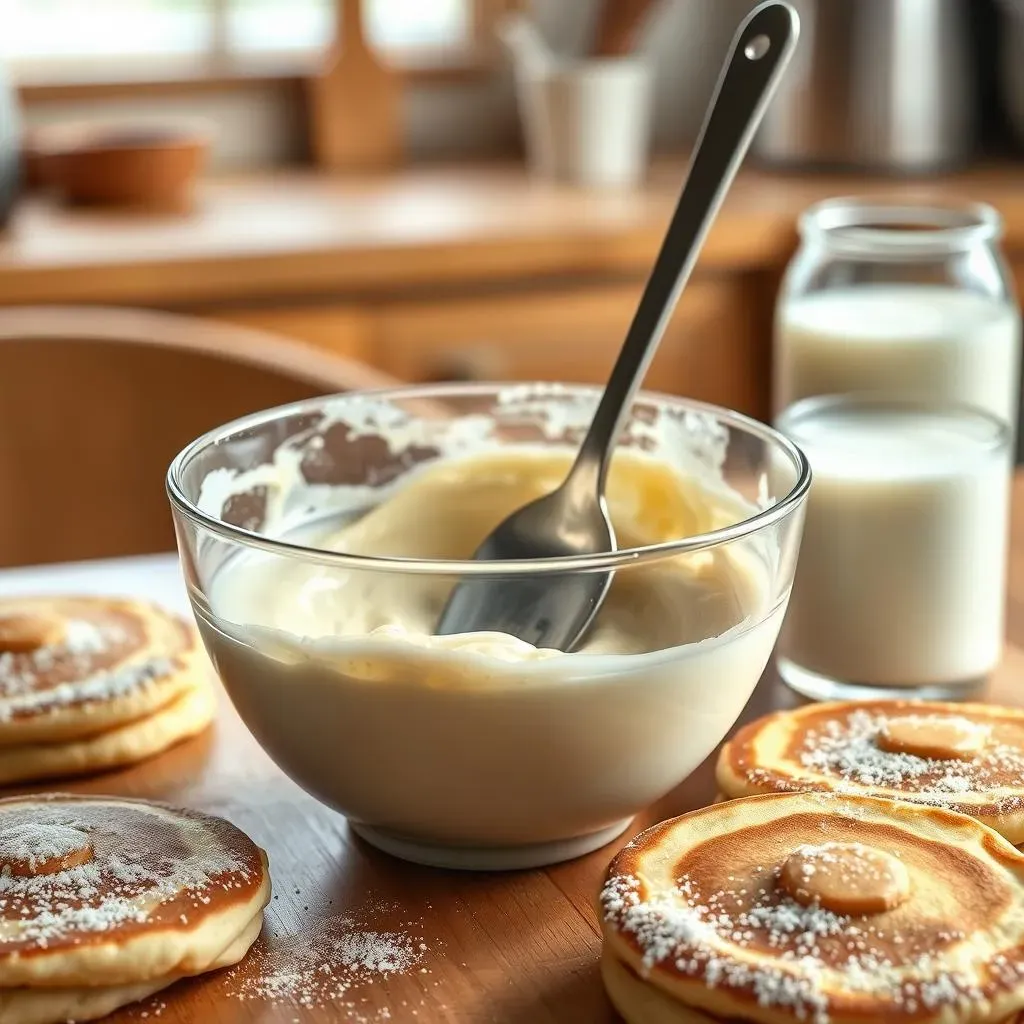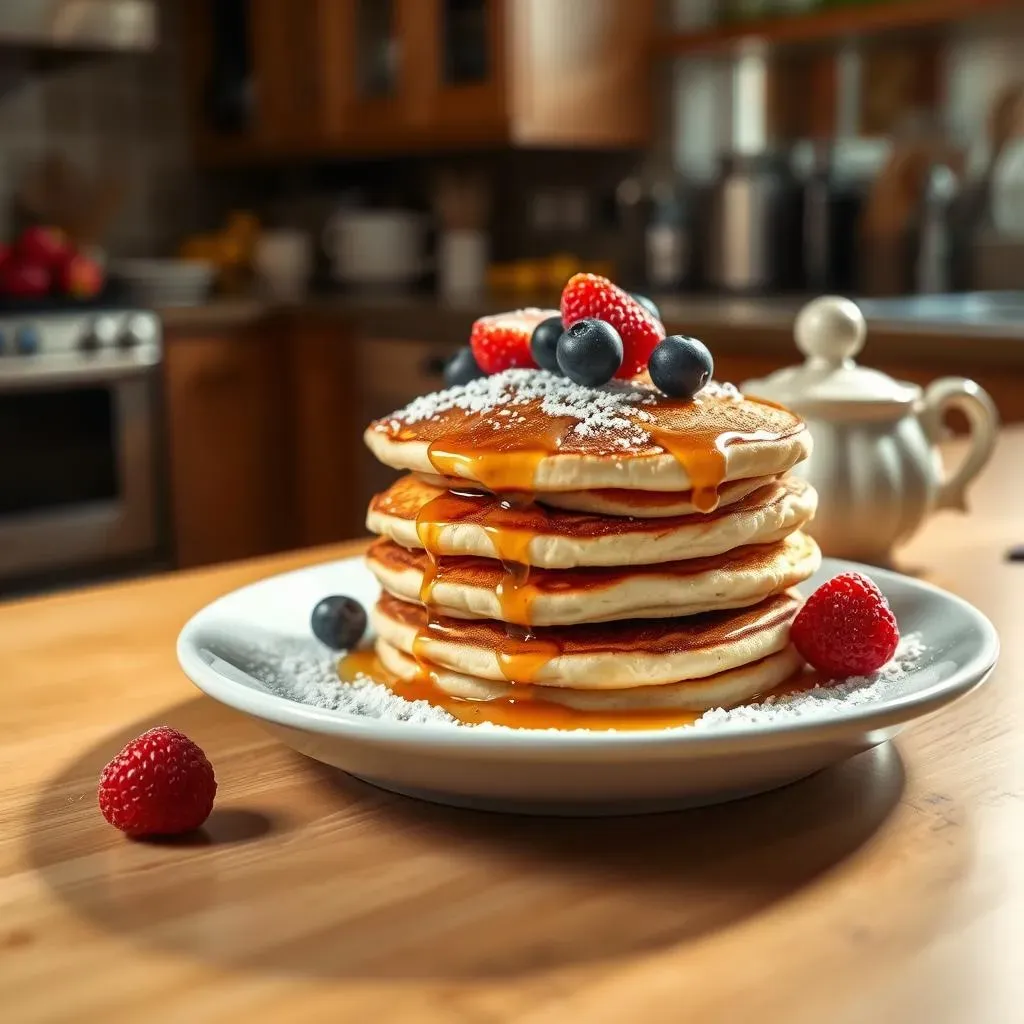Table of Contents
Ever stared at a stack of sad, flat pancakes and wondered, "Why are my pancakes not fluffy?" I have. It's a kitchen mystery that plagues many of us. You follow the recipe, yet somehow, your breakfast dreams deflate faster than a punctured tire. This isn't some culinary curse; it's usually down to a few common mistakes. This article will walk you through the main culprits behind dense, disappointing pancakes. We'll tackle the overmixing menace that activates gluten, leading to chewy results instead of fluffy clouds. I'll show you how the batter's consistency plays a crucial role, and why a too-thin or too-thick mix can ruin everything. We'll also cover the heat—the right temperature is key for that perfect rise. And finally, I'll share some extra tips and tricks, like secret ingredients that can take your pancake game to the next level. So, get your spatulas ready, and let's turn those flat disappointments into fluffy masterpieces.
The Gluten Culprit: Why Overmixing Ruins Your Pancakes Fluffiness

The Gluten Culprit: Why Overmixing Ruins Your Pancakes Fluffiness
The Overmixing Trap
so you’re whipping up a batch of pancakes, feeling like a breakfast superstar, right? But here's the thing: the more you mix that batter, the more you're developing gluten. Now, gluten is fantastic for things like bread, where you want that stretchy, chewy texture. But in pancakes? It's the enemy of fluffiness. Think of gluten like tiny rubber bands; the more you work them, the tighter they get. This is what makes pancakes tough and dense, instead of light and airy. So, that enthusiastic mixing you're doing? Yeah, it might be the reason you're staring at flat, sad pancakes.
It's all about gentle handling. Imagine you're folding in delicate clouds, not stirring a cauldron of some potion. You want to combine the wet and dry ingredients until they're *just* mixed, maybe with a few lumps still hanging around. Those lumps are actually your friends. They are signs that you haven't activated too much gluten. It's a bit counterintuitive, I know, but trust me on this. Overmixing is a super common mistake, and it's the top reason why pancakes go from promising to pathetic. Less is more, my friend. Less is definitely more in the mixing department.
Mixing Action | Gluten Development | Pancake Outcome |
|---|---|---|
Vigorous, long mixing | High gluten | Dense, tough, flat |
Gentle, minimal mixing | Low gluten | Light, fluffy, airy |
Signs of Overmixed Batter
How do you know if you've gone too far? Well, the batter will look smooth and almost gluey. It won't have that slightly lumpy, pourable consistency you're aiming for. You might even notice it getting thicker the longer you mix. That's the gluten working its magic, or rather, ruining your pancakes. Another sign is that your pancakes are tough and chewy. They should be tender and soft. If they are chewy, you've definitely overmixed. It's a common pitfall, but once you recognize the signs, you can easily avoid it. Think of it as a gentle dance, not a wrestling match. Your batter should be treated with the utmost care.
So, the next time you're making pancakes, remember: mix gently, mix briefly, and embrace those lumps. Your future fluffy pancake self will thank you. It's not about being lazy; it's about being smart. And who doesn't love a fluffy pancake? I know I do. It's one of life's simple pleasures, and it's definitely worth learning the art of gentle mixing to achieve pancake perfection. Now, let's move on to the next secret of fluffy pancakes: batter consistency.
Batter Basics: The Right Consistency for Light and Airy Pancakes

Batter Basics: The Right Consistency for Light and Airy Pancakes
The Goldilocks Zone of Batter
so we've tackled the overmixing monster, now let's chat about batter consistency. It's like Goldilocks and her porridge – you want it just right, not too thick, not too thin. If your batter is too thick, your pancakes will be dense and heavy, like hockey pucks instead of fluffy clouds. Think of it as trying to bake a cake with too much flour – it’s going to be a brick. On the flip side, if your batter is too thin, you'll end up with flat, sad, crepe-like pancakes that spread all over the pan. It's like trying to paint with watercolours instead of acrylics – it's just not going to have any body. So, how do you find that sweet spot?
The ideal pancake batter should be pourable but not watery. It should have a slightly thick, luscious quality, kind of like a thick milkshake or melted ice cream. When you lift a spoonful, it should slowly drip back into the bowl, leaving a ribbon-like trail. If it's too thick, add a splash of milk or water until you get the right consistency. If it’s too thin, add a spoonful of flour at a time, mixing gently until you see the batter thicken. It's a bit of a dance, adjusting as you go, but with a little practice, you'll nail it every time. It’s all about that feel, that sense of 'this looks right.' Don't be afraid to experiment, and remember, it's okay to add a little liquid or a little flour if you need to.
Batter Consistency | Pancake Outcome |
|---|---|
Too Thick | Dense, Heavy |
Too Thin | Flat, Spreads Too Much |
Just Right | Light, Airy, Fluffy |
Resting the Batter: A Crucial Step
Here's another secret weapon for fluffy pancakes: letting your batter rest. I know, I know, you're probably thinking, "Rest? I'm hungry now!". But trust me on this one. Resting the batter for about 5-10 minutes allows the flour to fully absorb the liquid. This means the batter will thicken slightly, and the gluten will relax, which actually helps with tenderness. It also allows the baking powder to do its thing, creating those tiny air bubbles that make the pancakes light and airy. It's like giving your batter a little spa day before its big debut on the griddle.
Think of it like letting a good wine breathe, it enhances the flavor and texture. When you skip the resting period, you're missing out on this crucial step. It’s a small step, but it makes a world of difference. So, while you're waiting, you can prep your toppings, or perhaps pour yourself a cup of coffee. It’s a win-win situation. Now that we've got the batter consistency down, let's move on to the next important factor: the heat.
The Heat is On: Proper Cooking Techniques for Fluffy Results

The Heat is On: Proper Cooking Techniques for Fluffy Results
The Goldilocks Temperature
so we've got our batter mixed just right, now it's time to talk heat. Think of your pan or griddle as the stage where your pancakes will perform. If the heat is too high, your pancakes will burn on the outside while remaining raw on the inside. It's like trying to bake a cake in a furnace – it's going to be a disaster. On the other hand, if the heat is too low, they'll just sit there, absorbing grease and never getting that lovely golden-brown color. It's like trying to cook an egg on a lukewarm stove – it's just going to take forever and probably not taste very good.
The sweet spot is medium-low heat. You want the pan to be hot enough to cook the pancakes evenly, but not so hot that they burn before they have a chance to rise. A good test is to flick a tiny drop of water onto the pan. If it sizzles and evaporates quickly, the pan is ready. If it just sits there, it's not hot enough. It’s a bit of a guessing game at first, but with a little practice, you'll get the hang of it. Think of it like finding the perfect temperature for a shower – not too hot, not too cold, just right. It's all about balance, and finding that balance is key to perfect pancakes.
Heat Level | Pancake Outcome |
|---|---|
Too High | Burnt Outside, Raw Inside |
Too Low | Greasy, Flat, Pale |
Medium-Low | Golden Brown, Cooked Through, Fluffy |
The Art of the Flip
Now, when it comes to flipping, patience is key. Don't rush it. Wait until you see bubbles forming on the surface of the pancake and the edges start to look set. This usually takes about 2-3 minutes. It's like waiting for a flower to bloom – you need to give it time. If you flip too early, you'll end up with a mangled mess. It's like trying to catch a fish before it’s even nibbled the bait. Once you see those bubbles and the edges are set, use a thin spatula to gently slide under the pancake and flip it over. Cook for another 1-2 minutes on the other side until it's golden brown. It's a simple technique, but it takes practice to perfect. It’s like learning to ride a bike – it might feel wobbly at first, but soon it'll be second nature. And the reward? A perfectly cooked, fluffy pancake, ready for all your favorite toppings.
Remember, each pancake is a little different, so adjust your cooking time as needed. Don't be afraid to experiment and learn what works best on your stove. It’s all about finding your groove. Now that we've mastered the heat, let's move on to some secret ingredients and tips that can take your pancake game to the next level.
Beyond the Basics: Secret Ingredients and Tips for Extra Fluffy Pancakes

Beyond the Basics: Secret Ingredients and Tips for Extra Fluffy Pancakes
The Fizz Factor: Sparkling Water or Club Soda
so you've nailed the mixing, the consistency, and the heat, but what if I told you there's a secret ingredient that can take your pancakes to a whole new level of fluffiness? I'm talking about sparkling water or club soda. Seriously! The carbonation in these bubbly beverages creates tiny air pockets in the batter, which result in unbelievably light and airy pancakes. It’s like giving your pancakes a tiny, fizzy lift. When that batter hits the hot griddle those tiny air bubbles expand, creating a delicate, airy texture that’s just divine. It's a simple trick, but it's a game-changer.
Just replace some of the milk or liquid in your recipe with sparkling water or club soda. Don’t worry, it won’t make your pancakes taste like soda, it just adds that extra lift. It’s like adding a touch of magic to your batter. The ratio is usually about half and half, but feel free to experiment and see what works best for you. It’s like a little science experiment in your kitchen, and the results are delicious. It’s a simple tweak that will make a huge difference, trust me on this one.
Ingredient | Effect on Pancakes |
|---|---|
Sparkling Water/Club Soda | Creates air pockets, makes pancakes light and airy |
Regular Milk/Water | Standard liquid, does not add extra lift |
The Protein Boost: Egg Whites
Another trick up my sleeve involves egg whites. Now, you're probably already using whole eggs in your pancake batter, right? But here's the secret: separating the egg whites and beating them until they form stiff peaks, then gently folding them into the batter just before cooking. This adds another layer of airiness and structure. It's like adding tiny, fluffy pillows to your batter. The whipped egg whites create a meringue-like texture, which makes the pancakes incredibly light and tender. It’s like giving your pancakes a little protein boost and a whole lot of extra fluff.
Be careful not to overmix the batter once you've added the egg whites, otherwise, you’ll deflate all that lovely air. It’s all about that gentle touch. Think of it as folding in delicate clouds, not stirring a pot of stew. It's a little extra effort, but it’s totally worth it for that melt-in-your-mouth texture. And remember, it's not about being perfect; it’s about enjoying the process and creating something delicious. So, get those egg whites whipped up and get ready to make some seriously fluffy pancakes.
The Flavor Enhancer: Buttermilk or Yogurt
Finally, let's talk about flavor and moisture. Instead of using regular milk, try using buttermilk or yogurt. These ingredients add a slight tanginess and a lot of moisture, resulting in pancakes that are both flavorful and incredibly tender. It's like adding a secret ingredient that makes people wonder, "What's the secret?". The acidity in buttermilk and yogurt helps to tenderize the gluten, which makes the pancakes softer and more delicate. It's a little like adding a touch of magic to your batter. It's not just about the texture; it's about the overall taste and experience.
If you don't have buttermilk on hand, you can easily make your own by adding a tablespoon of lemon juice or white vinegar to a cup of milk and letting it sit for a few minutes. The result is a tangy, rich flavor that will elevate your pancakes. And if you're using yogurt, go for plain, full-fat yogurt for the best results. It's all about experimenting and finding what you like best. It’s like creating your own signature pancake recipe. So, grab some buttermilk or yogurt and let’s get cooking!
Fluffy Pancake Victory: From Flat to Fantastic
So, we've journeyed from flat, sad pancakes to the promise of fluffy, cloud-like stacks. Remember, the key isn't some magical ingredient, but rather understanding the science behind the batter. Overmixing is the enemy, so treat your flour with respect. The right consistency is your secret weapon, and don't underestimate the power of a properly heated pan. With these tips, you're not just making pancakes; you're crafting breakfast masterpieces. Now go forth, conquer your griddle, and enjoy the fluffy rewards of your newfound knowledge. No more flat pancake blues, just delicious, airy perfection every single time. You got this!